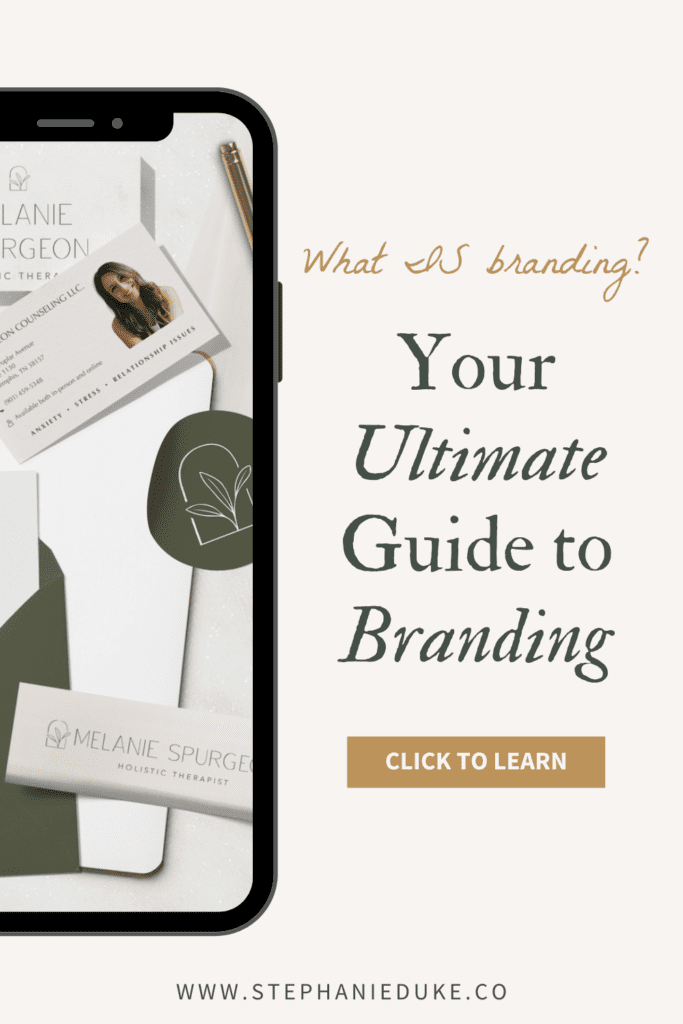What is Branding?
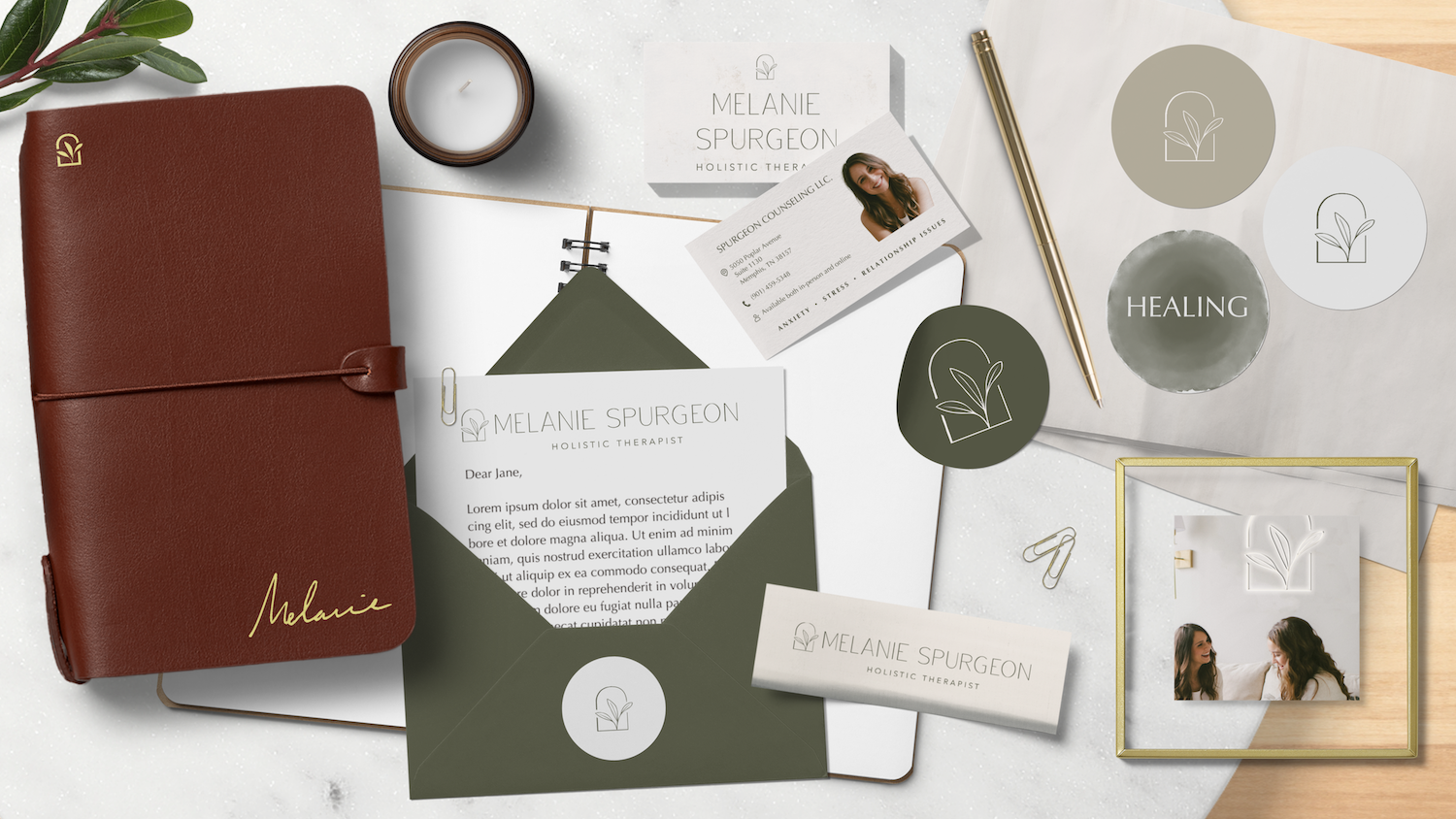
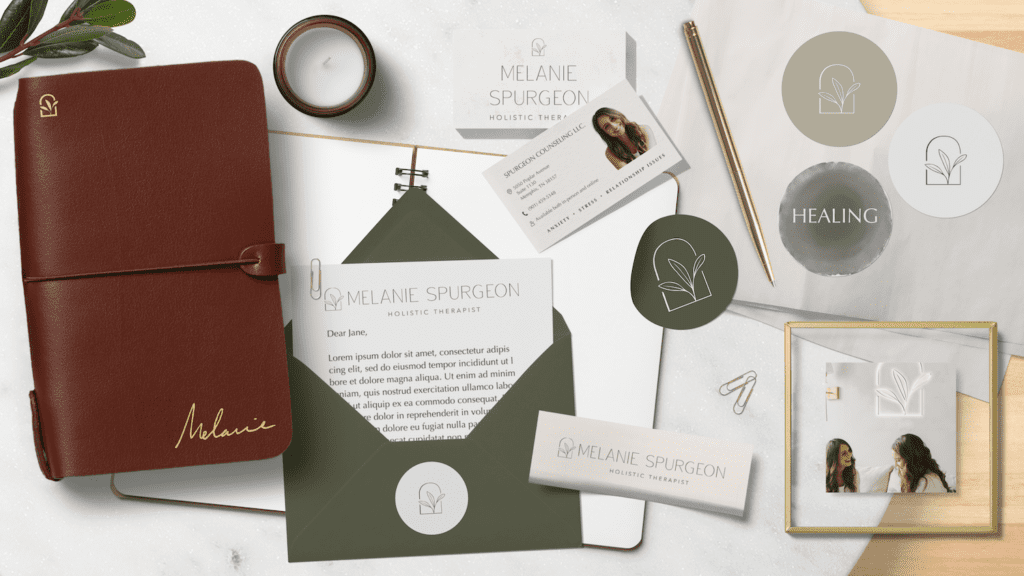
What is a logo? What is a brand? What is a rebrand? What do you DO? That question always makes me laugh. Today, I’ll go over some basic definitions of all things BRANDING and hopefully clarify some concepts for you along the way.
To start, I want you to know that every designer has a slightly different definition of all these terms and there are plenty of words or phrases/topics I’ll be leaving out today, just for time’s sake. No way I could cover the universe that is branding in a single article. It’s just too massive.
Let’s begin with some simple definitions before I really get into each term. I’ll be covering logo, brand, personal brand, branding, brand design, brand identity, brand strategy, brand positioning, rebrand, and brand refresh. Okay, here we go!
- Logo – a symbol that is designed to identify a business
- Brand – the result of a business’s efforts and reputation
- Personal brand – the result of an individual person’s efforts and reputation
- Branding – the process of creating a brand, often used as a blanket term for all these other words (mind you, often INCORRECTLY used…)
- Brand strategy – the process of deciding what a business is all about
- Brand positioning – how a business will differentiate itself in the marketplace
- Brand design – the creation of a brand identity
- Brand identity – the visual assets and guidelines of a business
- Rebrand – changing the brand identity of a business, and possibly its positioning
- Brand refresh – updating a single element or a few elements of a brand’s identity while maintaining its core identity
Alright, hopefully, that’s all clear as mud! If you are still confused, don’t worry, up next I’m going deep into each term with some examples that will clarify how these things all work together.
Logo
Again, the simple definition of a logo is a symbol that is designed to identify a business. You’ll notice the word brand is not used in that definition. That’s because a logo is not your brand. It also does not carry the weight of being your business’s entire identity. It is a tool in your business’s brand identity toolkit.
Remember, a brand identity is the visual assets and guidelines of a business. So your logo is a visual tool that helps people to identify your product, service, or content. THAT’S IT.
But like a screw in a carpenter’s toolkit doesn’t do any good without a screwdriver or a piece of quality lumber, a beautiful logo does you no good without other supporting tools like a color palette or marketing strategy.

Think about it. Would the image of an apple with a bite taken out of it have meant anything to you prior to 1976? If you’re wondering, that’s the year Apple was founded by Steve Jobs and Steve Wozniak. Absolutely not! Apple’s consistent dedication to the innovation of computer products along with their increasingly stellar product design, marketing, and customer service is what gave that little apple icon life.
The same goes for your business. You have to put in the effort to all the other parts of your business for your logo to eventually mean anything. Now there’s so much more I could speak on about logos, like the different types, variations, and legalities… but I’ll save that for a dedicated logo article. On to brand!
Brand
Here’s a simple definition refresher: a brand is the result of a business’s efforts and reputation. Let’s think of your brand like making a pot of soup. You can control a lot of the ingredients that make up your brand soup. That’s what we’ll call it, brand soup!
You can control your messaging, tone of voice, visuals, customer service, company culture, the products or services you create, and the content you put out. And you can do it in a strategic way that influences people to perceive you a certain way. So if you want your soup to taste southwestern, you intentionally add in southwest seasoning. If you want it to taste like chili, you’ll add chili powder. The individual ingredients change the flavor profile of the entire pot of soup.
How do we bring this back to your brand? You can be intentional about your tone of voice, your visuals, customer service, all that stuff BUT it all comes down to the individual consumer – the person seeing, reading, and interacting with your business. They have their own preconceived notions about the individual ingredients of your brand soup. This is the part you have no control over.
You can’t make somebody buy chili if they don’t like the taste of chili. It doesn’t matter if they like ground beef as an ingredient, if it tastes like chili – they aren’t going to buy it! On the flip side, someone who is a chili connoisseur (if there is such a thing, lol) will be much more likely to buy your chili, even just to try it. If they love it, they’ll come back for more. They’ll tell their chili-loving friends about your chili.
How many times can I say chili, and when did our soup turn into chili?
Anyway, like I said before, you can control a lot of what makes up your brand. But you can’t control how individual groups of people perceive your business. This is why it’s important to be strategic about who you are marketing to. The people that love your chili are going to be your biggest fans and champion you even when you aren’t around.
This is how you grow a brand.
You stay consistent with the parts you can control, and the right people will be along for the ride. Note that there will always be people who don’t like your brand – and that’s not because you’re doing anything wrong. They just aren’t your people, so they will naturally have a different opinion about what you’re doing. Someone who hates chili will say you’re one of the worst brands ever – but that’s subjective. They don’t even like your product, it doesn’t matter who is selling it – they still wouldn’t buy it.
All that crazy metaphor to say, your brand is a result of the things you control and your reputation. The key word here is result. You literally can’t create a brand overnight. It takes time. It takes effort. It takes all these other terms we’re discussing here, plus thousands of interactions with real-life people.
Know what you can control, and let go of the rest.
Personal Brand
I’ll quickly touch on personal brand, but it essentially has the same meaning as a plain ole brand – it just applies to a single individual. Think of your favorite influencer, celebrity, blogger, musician – even me, your resident brand and web designer! We all have a personal brand. Our businesses would not exist without us.
Now, personal brands can influence consumers the same way a large company like Apple does, but the reputation part plays a bigger role. I’ll use myself as an example here.
There are hundreds of people in my life that knew me before I ever started a business. People that have known me since I was a baby, kindergartner, middle schooler, high schooler, college student, etc. And there are hundreds of people that only know me because of my business. My personal brand means completely different things to those 2 groups of people, much less the individuals among them. I have to work extra hard to get people that have known me my whole life to see me as a professional businesswoman. I have found it is actually much easier to convince a stranger I know what I’m talking about than it is people in my personal life.
Obviously, this can vary depending on what you do for work, for instance, it might be harder to convince your grandma that being an “influencer” is a real job than if you were a lawyer starting your own practice. She is preconditioned to believe one of those occupations is more legit than the other. More on personal brands in another article.
Branding
The process of creating a brand. Pretty clear definition, right? Well, what does it actually mean? It’s kind of a hazy term to understand simply because there’s so much that goes into it.
Branding includes creating a brand strategy, your brand positioning, your brand identity, and presenting it all to the world in a way that invites the right people in. Some folks describe it as the process of creating your brand identity. But that doesn’t fully cover it. In order to ever create the visual pieces of your brand you have to have a strategy.
I can create a beautiful set of logos, a complimentary color palette, custom icons, the whole shebang – but it don’t mean a thang if it’s not sending the right message to the target audience of that unique business. You have to go in the right order. Here are the general steps of branding:
- Have the business idea
- Decide what you want to offer
- Decide who you want to offer it to
- Decide why those people should care about your offer
- Do market research
- Do competitor research
- Make adjustments to what your business is and what it offers
- Decide what your business stands for, what its personality is, how it should dress, its tone of voice
- Decide how much your offers should be
- Hire a brand designer to design your brand identity
- Apply your visual assets to your marketing and products
- Be consistent in your language, visuals, and service!
This isn’t a comprehensive list of branding, but rather a general idea of what all it entails. Many people skip right to selling. Sometimes this does okay for a bit, more often than not it flops at some point. Branding gives your business substance. Something for people to recognize, and connect to. Without going through this process, it will be very difficult for your business to stand out from the crowd.
Brand Strategy and Brand Positioning
Brand strategy and brand positioning both fall into the branding process. Brand strategy is the process of deciding what a business is all about and how to maintain that image while brand positioning is specifically figuring out how a business will differentiate itself in the marketplace. Strategy and positioning can both be short-term and long-term. It’s all about seeing a need in a market and determining how you can fill that need, uniquely.
Your strategy is the roadmap to how you’ll operate your business internally and externally, it informs what your brand identity will look like, and simply makes it easier to create products, services and content because you know what you stand for and what consumers expect of you. It can help you decide how you will market your business, the non-profits you’ll support, and relationships you pour into. It is truly the foundation of your business that everything else is built upon.
Meanwhile, your brand positioning is the space you take up in a consumer’s mind. It is what makes you unique and stand out from your competitors. Let’s look at some great positioning examples. We’ll play a little game.
- If I say sleek, innovative electronics company, you say…Apple.
- If I say international coffee shop you can work on your laptop at, you say…Starbucks.
- If I say futuristic, high-performance electric car company, you say…Tesla.
- If I say online marketplace that allows you to rent unique stays, you say…Airbnb.
I think you get the picture. These brands, Apple, Starbucks, Tesla, and Airbnb have all filled a gap in their industries that has allowed them to scale to some of the most known international brands in the world. Now that idea may scare you or excite you, but regardless of if you want to eventually be competing with Starbucks at an international level or you just want to make enough money in your business to cover a bill or two each month – positioning cannot be ignored. It matters and it works at all levels of business.
Brand Design and Brand Identity
My bread and butter. I’m going to talk about brand design and brand identity together, because these are 2 commonly interchanged terms among designers. Earlier, I defined brand identity as the visual assets and guidelines of a business and brand design as the creation of a brand identity. You may also hear this called your visual identity. But really it’s all the same thing: brand identity, brand design, visual identity, brand identity design, there’s a ton of variation in the wording.

It’s the visible pieces that make up your products and marketing. The colors, fonts, logos, photography, layout, icons, illustrations. I do not include marketing materials in this because collateral like brochures, websites, and merchandise are actually made up of your brand identity.
This is where a brand designer comes into the picture. I have many brand designer friends and every single one has a different philosophy for how they approach their work. So I’m only going to speak to my own approach, since it’s what I’m most familiar with.
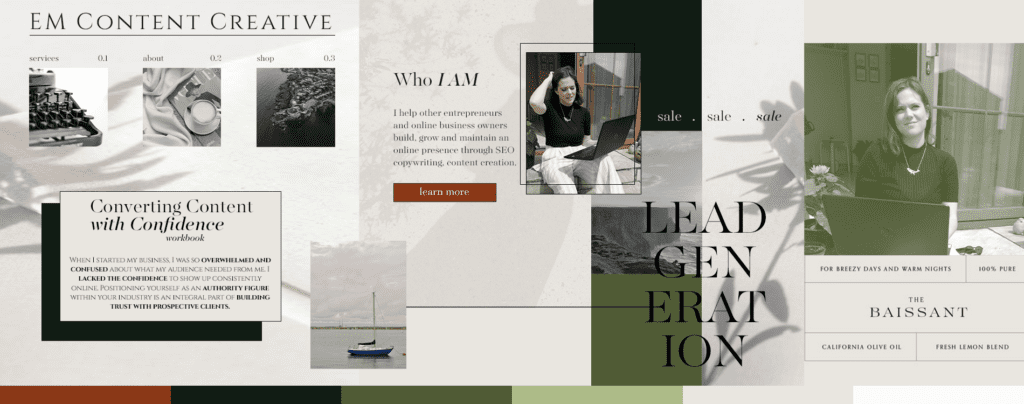
To me, what differentiates a brand designer from a logo designer is the strategy and branding process I described earlier as well as the additional deliverables you get from working with them. There is rarely any true strategy to what logo designers do. They’re often super cheap and appealing to new business owners because of this. And I don’t think that’s wrong, it’s just not comparable to what brand designers do. If you’re a logo designer reading this, please don’t be offended. There is a time and place for all areas of design.
If you have not gone through the initial branding process of figuring out who your target audience is, what your unique selling point is, what your values are, etc, etc… a brand designer can actually help you go through this process. After taking a client on the first thing I do is have them complete a brand workbook with a bunch of questions that not only help me understand their business better, but often helps them get more clear on their own messaging and purpose.
I’m skipping a few steps in the design process here, but what you can walk away with after working with a brand designer is:
- Clarity around your brand’s personality, tone of voice, and values
- Multiple logo variations for any and all use-cases
- A collection of fonts
- An extensive color palette
- Custom icons and or illustrations
- Custom patterns and textures
- Photography direction
- And most importantly, in my opinion, a multi-page PDF brand style guide
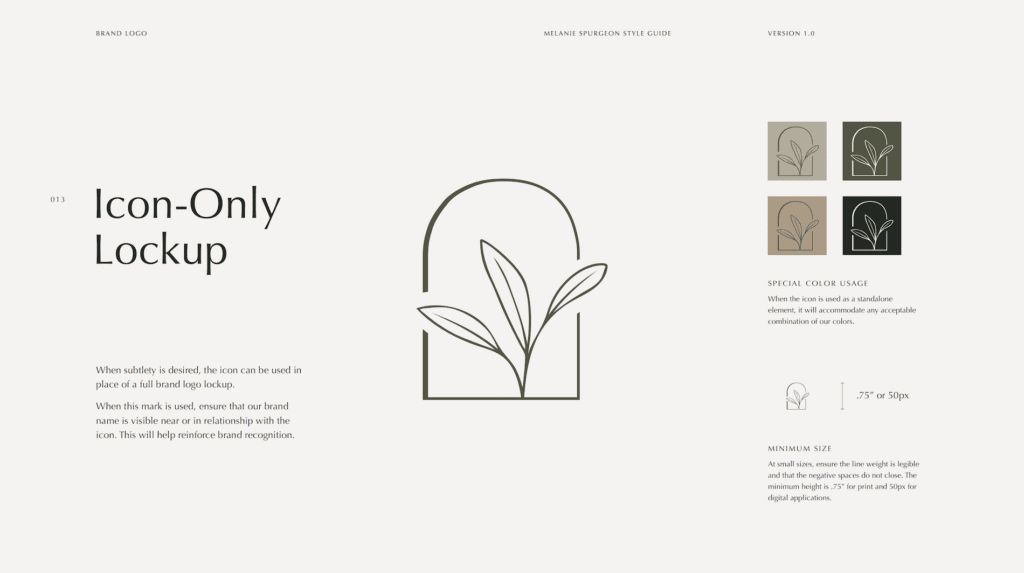
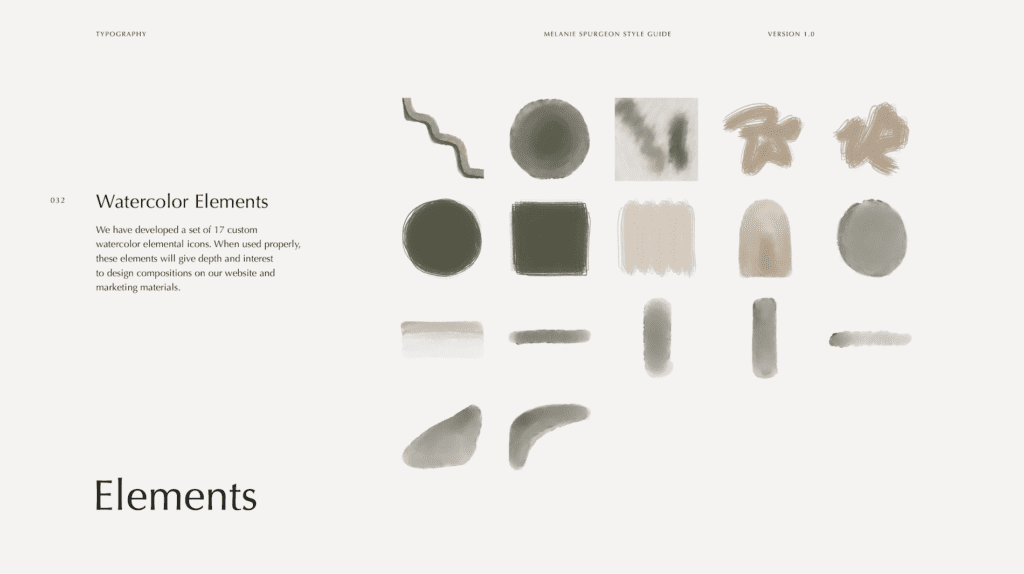
I’ll get into the brand style guide in another article, but basically it lays out the “rules” for using the elements of your brand identity. This helps you stay consistent in all of your marketing and is especially helpful if you have team members or hire contractors to create stuff for you.
Can you see how much more beneficial it is to work with a brand designer vs just a logo designer? Remember a logo is only intended to identify your business and this really only starts to happen after you’ve been in business a while and your reputation has started to build.
Rebrand
These last two terms I’ll explain are only relevant once you’ve been in business a while so if you’re new to business, please continue listening but don’t believe that this is something in your immediate future. A rebrand is changing the brand identity of a business, and possibly its positioning. It’s not always both though. Rebranding in small businesses usually happens after 2-5 years of building the business and this happens for a few reasons.
- You DIY’d your visual brand when you started your business and finally have the resources to work with a brand designer
- Your current visual brand is outdated or not robust enough for your growing needs
- Your target audience or service/product has changed
- Something about your visual brand just doesn’t feel right anymore, but you can’t put your finger on it
- You invested in your visual brand too early in your business and quickly learned it wasn’t a good fit, but felt like you had to keep it because of the money you poured into it. However, now that you have a solid grasp on your brand strategy and positioning you’re ready to do it again, forrealsies this time!
That’s just a few reasons why you might decide to rebrand, but really there are countless reasons why you could. Does that always mean you should though? Nope, and we’ll talk about that more in a future article.
Brand Refresh
Lastly, let’s talk about a brand refresh. Similar to a rebrand, a brand refresh is updating a single element or a few elements of a brand’s identity while maintaining it’s core identity. That probably doesn’t sound very clear, but let me explain further.
Let’s say you LOVE everything about your brand identity except for 2 colors in your palette, 1 logo variation, and you feel like you need more supporting pattern designs. Obviously you don’t want to fully rebrand, because you love MOST of your current identity – really the main parts that are most recognizable to your existing audience! So a refresh would be taking those elements you don’t love and reworking them to align more with the existing brand elements and in this case, adding the additional patterns.
This is a significantly more cost-effective option than a full-scale rebrand.
Now, more on the topic of rebrands and brand refreshes, there have been a toooon of well-known companies doing one or the other in the last several years. Actually, most large companies do some kind of refresh or rebrand every 7-10 years on average. Some notable ones are:
- Burger King
- Kraft Mac & Cheese
- Baskin Robbins
- Buick
- Kia
- Pringles
- Dunkin Donuts (who is now just Dunkin)
- Domino’s
- Weight Watchers
Click on the links for each brand so you can see what they changed. Some of you may not have even noticed some of the changes, they were so subtle and relied heavily on their existing brand.
I think it’s always a good idea to be watching what large companies are doing – successfully and not successfully – and applying what we learn to our own small businesses. Cause guess what? They were once small businesses too!
If the information in this article felt overwhelming, don’t worry I’ll be covering each topic more in its own article in the near future. Brand design is my first design love so I could literally write about it all day.
I hope you learned something valuable that you can apply to your own business situation, whatever that may be. And I want to encourage you, please don’t feel like your business or business idea is too small to consider any of this. Brand strategy and positioning are integral to all businesses, and brand design can truly make a huge impact on your business.
I’m excited to continue exploring brand design with you on this blog. If you have any specific brand-related questions, please send me a DM on Instagram @stephanieduke.co and I’ll gladly answer them in a future article. If you have any other questions, just want to say hey, or would like to work together you can find me at my website stephanieduke.co.
I’m Stephanie, but you can call me Steph!
I design brands & websites that get you butterflies-in-your-stomach-excited about your business again.
Simply put, I’m a graphic designer that specializes in brand identity design and Showit website design - arguably the most important aspects of your business! I live in central Alabama with my high school band directing hubby, Thomas, on our modest homestead in the country.
your guide to a stress-free website
FREE Website Planning Tool
- My exact Website Copy Planner Google Doc
- A master doc for keeping track of links and embed codes
- Loads of tips and tricks for planning website content (copy, photos, branding, etc) with ease
